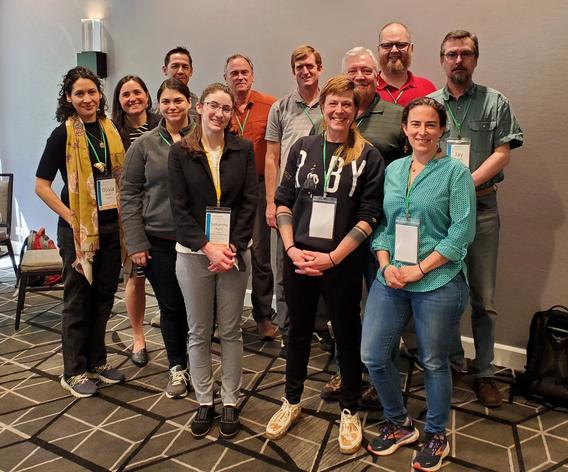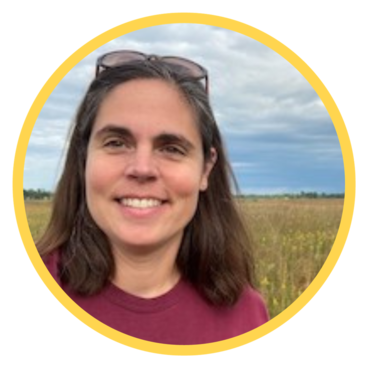
Several members of the Midwest Climate Adaptation Science Center community – including leadership, staff, and project leads – contributed to the newly published 5th National Climate Assessment (NCA5). The NCA5, released on November 14, 2023, is a federally-mandated report that assesses current and future risks posed by climate change to all U.S. regions, including the Midwest. It is designed to help decision-makers at all levels of government understand and respond to climate change.
The report includes physical science chapters, which assess how climate change affects physical Earth systems; national topic chapters, which summarize risks related to climate change and ways to address them; regional chapters, which explore region-specific challenges, opportunities, and success stories; and response chapters on adaptation and mitigation. The NCA5 also has a companion art gallery.
The process to develop the NCA5 was extensive, involving multiple rounds of review from experts and the general public. Contributing authors were selected based on technical expertise, disciplinary background, career status, and geographic representation.
To explore the scope and value of the NCA5, we asked several contributing authors about their experience writing the report. These interviews will be published over the next few weeks. Click an author’s name below to learn more!
- Sara Smith – Read her interview!
Midwest Climate Resilience Liaison, MW CASC & College of Menominee Nation
Contributing author, Midwest Chapter - Michael Dockry – Read his interview!
Assistant Professor, University of Minnesota & Tribal Relations Lead, MW CASC
Contributing author, Indigenous Peoples Chapter - Marissa Aherling – Read her interview!
Science Director, The Nature Conservancy & Project Lead, MW CASC
Contributing author, Northern Great Plains Chapter - Olivia LeDee – Read her interview!
Regional Administrator, MW CASC
Contributing author, Midwest Chapter - Melissa Kenney – Read her interview!
Director of Research and Knowledge Initiatives, University of Minnesota's Institute on the Environment & Postdoc Advisor, MW CASC
Contributing author, Adaptation Chapter
Sara Smith, Midwest Climate Resilience Liaison, MW CASC

What was the process of contributing to the National Climate Assessment like?
This was the first National Climate Assessment that I have been an author on. I was chosen for the Midwest Chapter based on my expertise as a liaison between Tribes in the Midwest, the Bureau of Indian Affairs, and climate science researchers and for my understanding of the important connections between climate and impacts on Indigenous peoples. The author team for the Midwest Chapter is a really strong group in terms of individual expertise. It has been a wonderful experience working with them. Most of the meetings and work was done virtually besides one in-person meeting I was able to attend in Washington D.C. earlier this year. The process was took a little over 2 years from the time I was invited to join the team.
Did you run into any challenges while working on the report?
Getting specific language and terminology approved in the chapter was a challenge since in some cases it was not something widely used or accepted yet. However, since I was attempting to include more Indigenous perspectives, my author team backed my suggestions and we were able to get it approved. Another challenge was the length each chapter is allotted in the assessment since there is so much to cover and not enough space to do the region justice.
An example of inclusive language and Indigenous perspectives incorporated into the Midwest Chapter of NCA5:
The threat of invasive species is amplified by climate change. However, invasive species can be perceived in different ways: many Indigenous communities have holistic views of invasives, or non-local beings, who encompass both positive and negative attributes. For example, dandelions and common plantain are used medicinally in Anishinaabe communities. Understanding the gifts and teachings that beings have can change our interactions and resource management.
Adaptation May Ease Disruptions to Ecosystems and Their Services
Was the experience valuable to you?
Yes, this was an amazing experience. I got to establish and build on many working relationships with authors from this chapter, which has been really valuable to my professional life. As a liaison, building relationships is extremely important, especially with those that could partner with Tribal Nations.
Why do you think the National Climate Assessment is important?
The NCA is important because the authors in the assessment are experts who come together to assess the impacts of climate change. It provides the public and those working in climate change “updates” on what has happened since the previous assessment and also where there are gaps that can influence future endeavors. The information in the assessment is very user friendly and can be incorporated into things like educational materials, media products, planning, and general conversations. From what I have seen, the key messages and images get used quite often in other’s work, including my own.
How do you think public perception of climate change has changed, if at all, since NCA4 (released in 2018)?
Overall, I feel like the public has been more accepting of climate change since 2018. I see this in the funding arena where more funds are available for climate change work, meaning there is more demand for it. In addition, I have noticed the creation of more climate specialist jobs and that tells me there is a greater need for jobs specifically focused on climate change.
Sara Smith is the Midwest Tribal Climate Resilience Liaison for the MW CASC & the College of Menominee Nation. She contributed to the Midwest Chapter of the 5th National Climate Assessment.
Michael Dockry, Assistant Professor, University of Minnesota

What was the process of contributing to the National Climate Assessment like?
It was a great process. Our author team for the Tribes and Indigenous Peoples Chapter was mostly Indigenous people and it was really cool to be with all these Native scholars working on climate change and compiling information on climate change from an Indigenous perspective. We met at least monthly and mostly virtually. Having federal contacts from the U.S. Global Change Research Program (USGCRP) involved in the process was really good. They helped us with getting resources we needed, like if we wanted a map that showed something, there were people available to put figures or maps together from the information we provided them.
Kyle Whyte of University of Michigan was the lead author on this chapter. He was amazing to work with and he really kept us going as well. It is a big project, so there was a lot of coordination and a lot of supporting each other. Sometimes I found myself writing parts of sentences or finding references to fill in places.
Did you run into any significant challenges or successes?
It was just an honor to work with all of these amazing scholars and have Kyle Whyte and our counterpart Allyza Lustig from USGCRP supporting us. Allyza was on most of our meetings providing technical support.
As we say in the report, there are 574 federally recognized Tribes in the United States. We also have numerous Indigenous groups across the country and in U.S. territories. We wanted to make sure that we had expertise from the Pacific Islands, so we have scholars from throughout the entire footprint of what we call the United States. It was amazing to work with these people and everyone is as cool as the next.
Was the experience valuable to you?
Having a real opportunity to work with my colleagues, as there aren't that many Indigenous scholars at universities at this point. We are working to change that, but at this point, I'll just say for myself, you can feel a little bit isolated because you don't have a ton of colleagues. So bringing several of us together to talk about climate change, write together, get to know each other, laugh together, get upset together – all of that is really satisfying professionally as well as personally. Because I really believe that doing that is an amazing service and doing justice to our Tribal communities.
What’s something you’re especially proud of in this chapter?
I'm really excited about the way we framed the Indigenous Tribes and Indigenous Peoples chapter. We do highlight the risks that Indigenous peoples face, but that's not the majority of what we put down. We really looked at solutions and innovation in leadership from the Tribes around climate change.
One of our key messages is that self-determination is key to Indigenous people's resilience to climate change. That means supporting the Tribes and ensuring Tribes have the resources to make decisions that benefit their communities, adapt to climate change, and become more resilient. Adapting to climate change is something that we as Indigenous people have been doing for thousands of years. Here in the Midwest, when the glaciers retreated, we were there. 20,000 years ago, 15,000 years ago – we have been here and this climate and the landscape in general has been changing. Then with colonization, we faced massive climate, economic, and social changes. We've been through that. And now we're here at another massive shift in climate. We've been adaptable and resilient through these many, many, many generations. Highlighting that is important.
The other key message is that Indigenous leadership really needs to guide climate change response. I think we're at a point in history that Indigenous people should be taking the lead in responses to climate change and we highlight a number of examples across the country where Indigenous leadership is having a real impact.
What kind of impact do you hope the report will have?
I hope this report in general inspires our society and the world to finally deal with this pressing issue of climate change. We are not doing enough, I think that's what the report says. We need to do more. And with Indigenous leadership, truly honoring the sovereignty and the self-determination of Indigenous peoples. Putting them in the lead can really help us get through this next phase of transition to a more sustainable energy, ecological, and social future.
Michael Dockry is an Assistant Professor at the University of Minnesota and the Tribal Relations Lead for the MW CASC. He contributed to the Tribes and Indigenous Peoples Chapter of the 5th National Climate Assessment.
Marissa Aherling, Science Director, The Nature Conservancy

What was the process of contributing to the National Climate Assessment like?
This is my first time being an author, and it ended up being a pretty big lift in a lot of ways. It's a lot of organizing people – we met at least every other week over those two years. The chapter authors met virtually the entire time, except for the all-author meeting in April 2023. We had a few days in person and it was nice to come together and revisit the chapter content.
I was the lead for one of the key messages within the Northern Great Plains Chapter, which was focused on climate adaptation. Native Nations are definitely leading the way on thinking about climate adaptation, particularly in this region. The climate assessment has an Indigenous Peoples Chapter for the first time this year, but we wanted to make sure that Indigenous voices were highlighted in the Northern Great Plains Chapter too, and not just in a call-out box. We wanted their efforts to be integrated through the whole thing, which required a lot of outreach.
Adaptation is underway in the Northern Great Plains to address the effects of climate change. Agricultural communities are shifting toward climate adaptation measures such as innovative soil practices, new drought-management tools, and water-use partnerships (medium confidence). Several Tribal Nations are leading efforts to incorporate Traditional Knowledge and governance into their adaptation plans (high confidence). Resource managers are increasingly relying on tools such as scenario planning to improve the adaptive capacity of natural ecosystems (medium confidence).
Communities Are Building the Capacity to Adapt and Transform
Being an author was a great experience for me, because I got to meet a lot of new people in the space. I made new connections and we have already started talking about future collaborations.
What was the biggest challenge you faced while writing the chapter?
The biggest challenge is the word count. They give you something like 10,000 words for the regional chapters. The hardest part was figuring out how to organize the chapter in a way that is effective at getting as much information across as possible. We had all these great conversations with various Native Nations and partners including the Sicangu Lakota and the National Park Service about work that they're doing, and it all gets boiled down to one sentence, because there are so many things across so many states. There are so many things that we had to include as just a citation. So that was definitely the hardest part, trying to prioritize what gets in and how to include all the important things there are to say in such a small amount of words.
How was the process valuable to you?
Personally, it was enjoyable and gratifying as a scientist to be able to work on such an important assessment for the U.S. In terms of thinking about climate change, how it's impacting our country, and what we need to be doing about it and making sure that those messages are getting out there.
It was also valuable professionally, in terms of making new connections. I have been delving into the world of climate adaptation with The Nature Conservancy (TNC) and our work. But I would say it's somewhat new for me – we've been thinking about it for a while on the ecosystem side, but it was really good to talk with colleagues who are thinking about adaptation in a broader sense with local communities, adaptation that's driven by people’s needs. TNC is considering, how do we lead? Are there places where we can lead on ecosystem-based adaptation driven by human priorities, like around floodplain issues? In Nebraska, for example, they've been suffering a lot from flooding in the spring. These big floods happen, then there's disaster relief, and then they try to build in adaptation as part of the disaster response, but that's after the fact. In river connection, floodplain restoration, and wetland restoration, there are things that we could be doing to help alleviate those flood impacts. I don't have all the answers yet, but I have a lot more questions and a lot more leads, colleagues, and resources to look to as we think about bringing that into our work going forward.
Is there anything you are especially proud of accomplishing in this chapter?
I'm proud of the examples that we were able to call out around adaptation that is happening in the region. I wish that we had space for more, because it was really great to see all the work that is being done. So much of the Northern Great Plains is rural and there are challenges around depopulation. That in and of itself decreases the resilience of these communities because they just don't have the infrastructure or the people to help adapt. I hope that people can find it hopeful, that there's work being done, and recognize that there are more needs in this region than some people are thinking about.
What kind of impact do you hope the report will have?
I hope people are able to pick it up and understand what the challenges are. Obviously, we highlight the projected climate impacts, that’s a big part of it. But we’re at a point where adaptation is not optional anymore—I mean, not that it ever really was, but we know that climate change is happening now. I hope that people can see that and realize there's a lot to be done. How are we going to deal with these challenges both for people and for ecosystems? And how can we help those things work together?
Is there anything else you'd like to share about the report?
I would say overall, I was impressed with how the U.S. Global Change Research Program (USGCRP) managed such a large project, with so many chapters and so many moving parts. Largely, they stayed on track with their timeline. That was no small feat, with many deadlines, drafts, and different orders of drafts. They did well and it was useful to see how they manage such a large undertaking.
Marissa Aherling is the Science Director for The Nature Conservancy in Minnesota, North Dakota, and South Dakota. She also serves as the PI for a MW CASC-funded project on climate-informed habitat restoration. She contributed to the Northern Great Plains Chapter of the 5th National Climate Assessment.
Olivia LeDee, Regional Administrator, MW CASC

What was the process of contributing to the National Climate Assessment like?
It was great having teams organized by chapters, either by geography – in our case, the Midwest – or by sectors. You get to work with a small group of people from your region, some who are experts in your area, but also people who might be experts in urban systems, in health systems, in agricultural systems. It's a great opportunity to share what's been happening in your research area and learn from others. And you get to work together in a team environment with high trust and high collaboration. It's just great. These are all folks who work really hard and are willing to commit to this pretty intensive effort for a period of time.
Did you run into any challenges while writing the chapter?
A couple. For one thing, the report doesn't summarize everything that's ever happened. Authors have to summarize what's happened since the last report – that's important. So we have to revisit what we've shared, for example, in NCA3 or NCA4, and what's new and noteworthy this time around. Sometimes it's difficult to build on what we have learned in, say, the last three or four years, but not go too deep into the legacy of information that leans on. That’s a big challenge, that it’s not a sustained assessment.
Another was word limits. They were tough. We probably cut half of what we started out with. The hard part was how to make it shorter while keeping the science accessible. Because for scientists, when we have to cut length we tend to go to shorthand – scientific jargon – which doesn’t work for the NCA. Making the language inclusive was also challenging. Again, it was a process of going back and forth with the U.S. Global Change Research Program (USGCRP) on what needed to be defined and what didn't. For example, in our chapter we reference the kin viewpoint that some Indigenous peoples have of fish, plants, wildlife in the Midwest, including using the term “beings”.
How was the experience valuable to you?
I see it as a service opportunity. It is something that is mandated by Congress, it is very important. I've always valued the National Climate Assessment and used the products, so to be able to offer that benefit to others was very personally fulfilling. It was also a nice opportunity to step back and reflect on what we've learned and what the information gaps are.
Why is the National Climate Assessment so important?
If you want to know broadly how climate change is affecting our country, that's the place you go. And it's updated every five years, which is amazing.
The assessment can also be used in a few different ways. 1) It helps decision makers and policy makers at regional, state, and to some extent local levels determine the main issues, what's most at risk, and identify adaptation opportunities. 2) It’s a resource for educational communities. The current and prior assessments can be used in developing scientific curriculum and can provide a foundation for university programs. 3) It can be used to foster dialogue among communities. This is something that scientists and others have documented. The assessment can be used as a starting point for conversation about public infrastructure, human health, and climate change. 4) Research in the assessment can be integrated into planning documents. It can – and it has – inform state and national level planning efforts.
How do you think public perception of climate change has changed, if at all, since NCA4 (released in 2018)?
There is wider recognition, I think, of climate change happening in the Midwest. Previously, I think people often thought about Alaska, the Arctic. I think there's greater appreciation of the reality that it's not just warmer temperatures, it is drought, it is flooding. And that we have the capacity and ability to respond to climate change and implement adaptation. We’re seeing more resource managers being innovative and applying adaptation practices on the land, which we highlight in the Midwest Chapter.
Olivia LeDee is the Regional Administrator for the MW CASC. She contributed to the Midwest Chapter of the 5th National Climate Assessment.
Melissa Kenney, Director of Research and Knowledge Initiatives, University of Minnesota's Institute on the Environment & Postdoc Advisor, MW CASC

What was the process of contributing to the National Climate Assessment like?
It is a really fun and interesting process. I was part of the Third National Climate Assessment about a decade ago and was really excited to be part of this edition. There are very few processes that exist within our scientific landscape where the charge is literally to synthesize research for the nation. Our Adaptation Chapter author team was really dynamic. It was one of those groups of collaborators that gel pretty quickly.
Adaptation refers to actions taken to reduce risks from today’s changed climate conditions and to prepare for further impacts in the future. It includes diverse activities designed to reduce climate-related risks and increase capacity to prepare for climate impacts. That’s because even if we turned off the greenhouse gas pipeline today, there will be climate changes because of the warming we've already committed ourselves to. We need to adapt regardless.
In our chapter, we emphasized that there’s a need to move beyond incremental, small-scale actions and toward transformative actions to prepare communities and ecosystems for large-scale climate change. For example, moving from installing individual air conditioning units in buildings to thinking about district heating and cooling. Or, as buildings age out, completely rethinking building materials and how we can build structures that require less energy and integrate renewable electricity technologies.
And critical to facilitating these solutions, is that adaptation plans and action need to advance equitable and just solutions; adaptation solutions that are only available to a subset of people are not just and transformative. We need to ask questions like, “Who can pay more for air conditioning during a heat wave? Who may be excluded from access to particular adaptation solutions?”
Is there anything that you're especially proud of accomplishing in the chapter, or that you feel is especially important?
Importantly, in this year’s assessment, we worked to emphasize that scientific information and tools are really critical, but that's not the entirety of climate services – or climate information to support decision-making. Oftentimes, the way that decision-making happens is through the development of communities and networks, the co-development of tools and resources, and science that is responsive to the needs and expertise of the decision-makers. It also requires ensuring that the voices that decide how those tools and data are structured encompass those who are impacted but whose voices have not been amplified, so we don’t end up perpetuating unjust outcomes.
Did you run into any challenges while working on the chapter?
One of the greatest challenges is that many adaptation activities are happening within private industry and NGOs, but we don't have a good mechanism to collect those case studies. There are requirements for the synthesis research that goes into a government report like the NCA5, including justification and citations for every scientific claim. Developing more inclusive mechanisms to incorporate local and Indigenous knowledge was a major innovation in the NCA5, but I think there is more opportunity to think about ways to identify and collect information, stories, and case studies that would allow us to more comprehensively understand the state of adaptation.
How was the experience valuable to you?
I got to work with new colleagues! And working with them has made me think about adaptation indicators and climate services in new and more expansive ways. And that’s because of the new people who were brought into NCA5 – this was the most diverse, inclusive, and comprehensive National Climate Assessment to date. It included over 400 authors across 32 different chapters.
You were involved in a previous iteration of the report, NCA3. What has changed since then in terms of climate adaptation?
The big transformation over the past decade is that we no longer need to convince people that climate change is happening. We see it every day. We see it in winter coming later here in Minnesota. As a result, we're seeing actions happen from local to national levels to create the infrastructure that will enable governments and communities to adapt.
In Minnesota, some of the legislation requiring climate adaptation plans over the next couple of years will be critical for laying the foundational step to implementing adaptation actions not just in the metro areas, but across the entirety of the state. Nationally, I think the infrastructure bill and the IRA are providing critical funding that enables governments and organizations to be able to create a more resilient future by reducing greenhouse gasses and deploying adaptive actions. The exciting thing about policies of that scale is that they create mechanisms for systemic change. It's really hard for individual people or single organizations to accomplish that, but when you create the infrastructure, it makes it easier to do things that support the collective good.
We see this with the transformation of electric vehicle (EV) technology. Just a year or so ago, EVs passed the 5% market share milestone, which is massive because, typically, once you get that level of market share, you hit an inflection point. That, coupled with these investment bills, will enable the infrastructure to start transforming our transportation sector, which will create opportunities to electrify our fleets, and as we transition more and more of our electricity grid infrastructure to renewables, we’ll be able to transition the majority of our transportation networks into that carbon-free technology. So, it's exciting to be at this stage where we’re hitting some inflection points that will make things easier. We're going to start seeing the infrastructure that allows for that transformation to happen. And then that allows us to think, for example, what does owning an EV look like in more rural areas? In cold climates, like Minnesota, where battery longevity is significantly impacted by temperature?
Anything else you want to share?
I am an expert in indicators – or easy ways that we systematically measure things that we care about. There is growing interest in adaptation indicators – both to measure project goals and to more holistically assess the state and effectiveness of adaptation across multiple projects.
Over a decade ago, I led a process with over 200 experts from academia, federal, state, and local governments, private industry, and NGOs to develop a framework for a national indicator system that would be a sustained climate assessment product. That tool came out in May 2015. It was adopted by the U.S. Global Change Research Program, which supports the National Climate Assessments, and showed up in the Fourth and Fifth National Climate Assessments. I wasn't involved specifically in the NCA5 Indicators Chapter, but was really excited to see that legacy of our work continue on. I hope this is something that carries forward, because it creates a way of systemically tracking how things have changed in key systems, going beyond regularly measured things like temperature, changes in precipitation, and greenhouse gasses. If we're not tracking it in a systematic way over time, we have no way of being able to comprehensively understand changes that have occurred.
And I often get questions about adaptation indicators. NCA5 didn’t officially include adaptation indicators, but in our chapter one adaptation indicator included a map of the adaptation plans and actions that have occurred since the Third National Climate Assessment. Importantly, we were able to document that there is activity happening in every single state and territory within U.S. jurisdiction – that wasn't the case a decade ago.
Even though there’s some initial work on adaptation indicators, there are still significant research gaps. One area of research that I am excited to pursue, partly motivated by our chapter, is thinking through how adaptation indicators could catalyze transformative adaptation. Indicators can create a shared currency by which we measure things and create accountability toward collective goals. However, a lot of the adaptation indicators up to this point have been project by project. I think there's an opportunity, because there's been so much adaptation planning happening, to understand what common goals exist amongst our communities and amongst different groups of people and entities. I think when we're working together, even if individually what we’re doing is incremental adaptation, collectively we're doing transformative adaptation. Some of the work that Dee Lobo is leading with the MW CASC’s first synthesis project will potentially set the stage for thinking about this within natural resource management contexts.
And even though adaptation indicators are not currently included in the National Climate Assessments, I'm excited to see what might emerge in future versions. Hopefully, the work we're doing with the Midwest CASC on synthesizing adaptation plans – and future work proposed on adaptation indicators – can be exemplars for adaptation indicators that can be used by states and in future synthesis reports to assess whether we are adapting effectively and fast enough.
Melissa Kenney is the Director of Research and Knowledge Initiatives at the University of Minnesota's Institute on the Environment. She also serves as the Postdoc Advisor on the MW CASC’s synthesis research project, “Assessment of Adaptation Plans and Practices for Natural and Cultural Resources.” Melissa contributed to the Adaptation Chapter of the NCA5.
